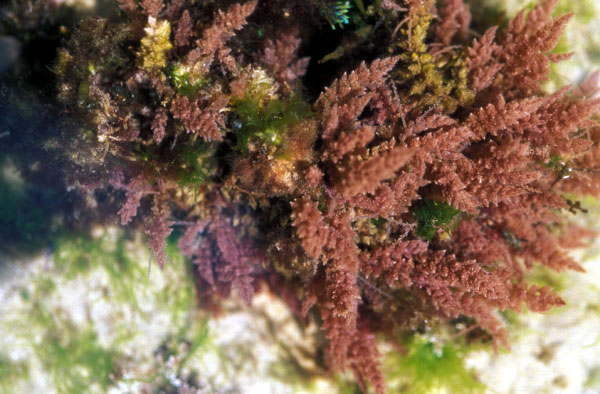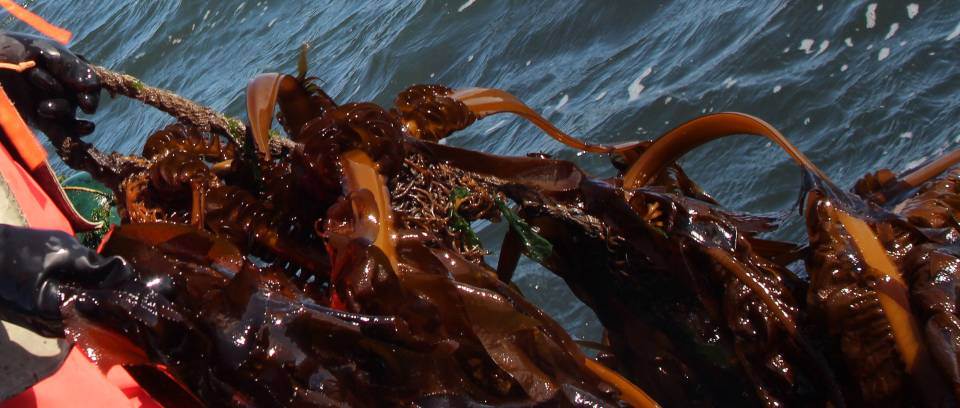Gracilaria edulis. a major Indian agarophyte. has been successfully cultivated in an experimental scale from spores at sea off Narakkal, Kochi. Artificial objects like noating roft. nylon ropes and net pieces were provided in the open sea for collect ion of spores of GracUaria edulis. They were allowed to grow to mature size of 30 cm. After 76 days of culture period, fully grown healthy plants of Gracilaria edulis were harvested from the nylon rope by hand pruning. Further growth was much faster. A total yield of 7.220 kg plants was obtained during 122 days of the culture period. The work has resullcd in the successful cultivation of the species from the east coast to a coastal area of the west coast, Narakkal, and also in the identification of a fertile culture ground (open sea off Narakkal. Kechi) along the Kerala coast during favourable period of growth.
Digital library
-
-
A culture system for the commercial production of the seaweed Gracilaria parvispora using shrimp-farm effluents for fertilization and floating cage-culture for grow-out has been developed on Molokai, HI. This two-phase system produces high-quality products for direct human consumption. The mean relative growth rates (RGRs) of effluent-enriched thalli in the cage system ranged from 8.8% to 10.4% day−1, a significant increase over the growth (4.6% day−1) of thalli fertilized with inorganic fertilizer. Thalli were also grown directly in the effluent ditch, where mean growth rates of 4.7% day−1 were obtained, less than in cage-culture. In the cage-culture system, thallus nitrogen content declined without fertilization. Effluent-enriched thalli grown in the cages steadily declined in nitrogen content, to about 1%, and their C:N ratios increased to between 20 and 30. However, when nitrogen-depleted thalli were transferred to the effluent ditch for enrichment, N content rapidly increased over 5 days to approximately 3%, with a C:N ratio near 10. Benefits of this two-phase polyculture system include enhanced growth of G. parvispora and the use of effluent from commercial shrimp farms as a resource.
-
Bladed Bangiales of the genus Porphyra/Pyropia are highly valuable red algae and extensively farmed in South East Asia. Interest is rising in cultivating species local to the North East Atlantic but the control of the heteromorphic life cycle of native species remains difficult as previous studies reported high inter- and intraspecific variability in required cultivation conditions. Here, working with Porphyra dioica from a UK source population, we conducted a series of experiments investigating the influence of substrate, temperature, photoperiod and light intensity on the development of early life history stages (conchocelis (filamentous sporophyte) and young thalli (gametophyte)). Special focus was the influence of temperature and photoperiod on mature conchocelis to induce a conchospore mass release—the current bottleneck of European Porphyra cultivation. Sporophytes grew largest on an oyster shell substrate and under long day conditions at 18 °C. A decrease in temperature from 18 to 9 °C initiated a mass conchospore release (498 ± 146 spores mL−1 ) from a P. dioica conchocelis culture grown in suspension. Released conchospores germinated into small thalli on nylon ropes, with best growth (7.2 ± 0.9% day−1 ) at low temperatures of 9 °C. Conchospore germination increased with decreasing light intensity but germination success was generally very low (< 5%), indicating the cultivation protocol needs further improvement. Our results reflect the adaptation of P. diocia to seasonal environmental conditions in temperate regions and the importance of these conditions for the successful cultivation. We are the first to describe a mass conchospore release for P. diocia growing in suspension which has important implications for commercial production.
-
Commercial cultivation of Caulerpa lentillifera is now gaining recognition because of the increasing demand in the domestic and international market. Studies on the different culture methods for large scale production of the species in the country are scarce. The present study evaluated the effects of two cultivation methods namely sowing and tray on the growth and biomass production of C. lentillifera cultured in brackishwater pond. For the tray method, propagules were clipped in two 0.75 m x 0.75 m tray and were hung in bamboo frame whereas for the sowing method, propagules were planted directly in the pond substrate with an interval of one meter. The weight gain using the sowing method was significantly higher and could be translated to an average of 1 kg every month of new or harvestable biomass. Specific growth rate of C. lentillifera grown in the substrate was at 3.85% day-1 during the first month and at 2.92% day-1 during the second month and was significantly higher compared to that of stocks grown in trays. High organic load of the soil (substrate) could have improved growth and biomass productivity. The results show that cultivation of C. lentillifera using the sowing method is more effective. This system has significantly contributed to increase in biomass yield. Moreover, this method of farming entails lesser capital outlay without any other material requirements such as bamboos and trays.
-
Consumer interest and demand for North Atlantic sourced sea vegetables drives opportunities for aquaculture development in the northeast USA. The unique morphology and desirable culinary traits of the wild narrow-bladed kelp, Saccharina latissima forma angustissima, were successfully translated into a cultivated crop on two geographically distinct open-water farms in Maine, USA. Environmental conditions, growth, and tissue analysis were quantified. Peak meristematic growth rates for blade length occurred from March through April at 2.85 (±0.34) cm day−1. The kelp was harvested from May through June with yields of up to 17 (±4.4) kg m−1 of line and plant density of 330 plants m−1 of line at the Bristol farm and yields of 13.3 (±6.2) kg wet weight m−1 line and a plant density of 400 plants m−1 of line at the Sorrento farm. Second season yields at Sorrento were on average 24.1 (±6.3) kg m−1 of line. Both farms grew significantly narrower blades of f. angustissima than of the sugar kelp, S. latissima. Common garden experiments with the two morphotypes identified trait stability for length and width, while blade ruffles and thickness varied with the environment. Calculations estimating the nutrient bioextraction capability of the cultivated f. angustissima kelp harvested in June reveal N removal of 88.7 kg ha−1 and C removal of 1666.7 kg ha−1 (combined farm site averages). Overall, this unique kelp form has the potential as a new aquaculture crop for the Gulf of Maine while providing several coastal ecosystem services.
-
Cultivated kelps and other macroalgae have great potential in future provision of food, feed, bioenergy, fertilizer, and raw material for a range of chemical products including pharmaceuticals, food and feed additives, and cosmetics. Only a few species are currently cultivated, almost exclusively in Asia. There is a range of species that could be utilized in different parts of the world, providing that protocols for reproduction, propagation, and cultivation are developed. Domestication of species involves selection of traits that are desirable in cultivation and in the utilization of the harvested biomass. Genetic improvement of cultivated species through recombination of alleles and selection (breeding) has ensured high productivity and product quality in both agri- and aquaculture and will likely do so for macroalgae cultivation and use as well. According to the published literature, genetic improvement of kelps in Asia has so far largely relied on utilization of heterosis expressed in certain combinations of parental material, sometimes species hybrids. Here, we explore and evaluate the various methods that could be used in kelp breeding and propose an initial simple and low-cost breeding strategy based on recurrent mixed hybridization and phenotypic selection within local populations. We also discuss the genetic diversity in wild populations, and how this diversity can be protected against genetic pollution, either by breeding and cultivating local populations, or by developing cultivars that are not able to establish in, or hybridize with, wild populations.
-
Crossing tests were made to determine the relationship between the identified Viva pertusa, which commonly grows in Japan as an attached form on exposed rocks, and the floating Viva forming "green tide" inside calm bays. The floating Viva thalli were collected from five major green tide sites in Japan (Yokohama, Mikawa, Miyajima, Kochi and Hakata). Reproductive maturation was induced in U. pertusa and the floating thalli from each site. Mating between induced gametes was observed. It is therefore believed that the floating thalli from Yokohama, Mikawa and Miyajima were mainly U. pertusa, while those from Kochi and Hakata were of a different species (Viva sp.l). Furthermore, the Viva species found in Mikawa is also a species (Viva sp.2) different from both U. pertusa and Viva sp. 1.
-
Kelp forests and Sargassum beds not only are commercially important in themselves but also play an important role in spawning, breeding and feeding grounds for many kind of fish, shellfish, lobster and other important fisheries resources (Komatsu et al. 1982; Komatsu 1985; Ohno et al. 1990; Watanuki and Yamamoto 1990; Terawaki et al. 1998). The distributions of kelp forests comprising of the Ecklonia and Eisenia species are restricted to warm-water regions. A number of ecological studies on these plants have been undertaken with particular attention focused the re-establishment of kelp forests. This is due to declining populations that are a result of various factors, including human activities (Tsutsui et al. 1996). Thus, there has been development of construction techniques of artificial foundation, for kelp forests, and transplanting techniques of seed and adult marine algae, on artificial foundations (Hasegawa et al. 1995). Techniques of formation for seaweed bed may fall under either of the following classifications: 1. Spore dispersal technique; 2. The spore bag technique; 3. Ropeseeding technique; 4. Adult-plant transplantation method; 5. Concrete blocks; 6. The threading technique; 7. Gravel-bag technique; and 8. Transplantation of young plants (Largo and Ohno 1993). In this study, we used the spore bag on the roof of an artificial iron reef and a natural rock for a seaweed bed. The present paper describes the formation of seaweed beds by the spore bag method on an artificial iron reef and a natural rock (habitat).
-
Kelp forests and Sargassum beds not only are commercially important in themselves but also play an important role in spawning, breeding and feeding grounds for many kind of fish, shellfish, lobster and other important fisheries resources (Komatsu et al. 1982; Komatsu 1985; Ohno et al. 1990; Watanuki and Yamamoto 1990; Terawaki et al. 1998). The distributions of kelp forests comprising of the Ecklonia and Eisenia species are restricted to warm-water regions. A number of ecological studies on these plants have been undertaken with particular attention focused the re-establishment of kelp forests. This is due to declining populations that are a result of various factors, including human activities (Tsutsui et al. 1996). Thus, there has been development of construction techniques of artificial foundation, for kelp forests, and transplanting techniques of seed and adult marine algae, on artificial foundations (Hasegawa et al. 1995).Techniques of formation for seaweed bed may fall under either of the following classifications: 1. Spore dispersal technique; 2. The spore bag technique; 3. Ropeseeding technique; 4. Adult-plant transplantation method; 5. Concrete blocks; 6. The threading technique; 7. Gravel-bag technique; and 8. Transplantation of young plants (Largo and Ohno 1993).In this study, we used the spore bag on the roof of an artificial iron reef and a natural rock for a seaweed bed. The present paper describes the formation of seaweed beds by the spore bag method on an artificial iron reef and a natural rock (habitat).
-
Background: The hydrolysis of seaweed polysaccharides is the rate limiting step in anaerobic digestion (AD) of seaweeds. Seven different microbial inocula and a mixture of these (inoculum 8) were therefore compared intriplicate, each grown over four weeks in static culture for the ability to degrade Laminaria hyperborea seaweed and produce methane through AD.
Results: All the inocula could degrade L. hyperborea and produce methane to some extent. However, an inoculum of slurry from a human sewage anaerobic digester, one of rumen contents from seaweed-eating North Ronald say sheep and inoculum 8 used most seaweed volatile solids (VS) (means ranged between 59 and 68% used), suggesting that these each had efficient seaweed polysaccharide digesting bacteria. The human sewage inoculum, an inoculum of anaerobic marine mud mixed with rotting seaweed and inoculum 8 all developed to give higher volumes of methane (means between 41 and 62.5 ml g-1of seaweed VS by week four), compared to other inocula (means between 3.5 and 27.5 ml g-1VS). Inoculum 8 also gave the highest acetate production (6.5 mmol g-1VS) ina single-stage fermenter AD system and produced most methane (8.4 mL mmol acetate-1) in phase II of a two-stage AD system.
Conclusions: Overall inoculum 8 was found to be the most efficient inoculum for AD of seaweed. The study therefore showed that selection and inclusion of efficient polysaccharide hydrolysing bacteria and methanogenic archaea in an inoculum offer increased methane productivity in AD ofL. hyperborea. This inoculum will now beingtested in larger scale (10L) continuously stirred reactors optimised for feed rate and retention time to determinemaximum methane production under single-stage and two-stage AD systems





